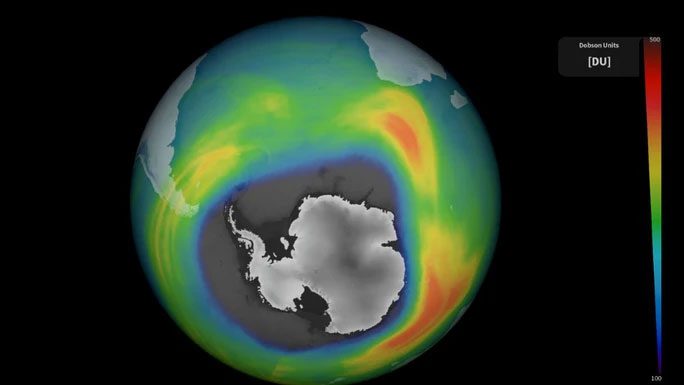Satellite data has revealed an unprecedentedly large hole in the Earth’s ozone layer above Antarctica, with the culprits being not only human activity but also the “monster” from the South Pacific.
According to the European Space Agency (ESA), which is monitoring the ozone hole using the Copernicus Sentinel tool, the ozone hole in Antarctica reached its maximum size on September 16, measuring 26 million km2.
This area is nearly equal to the size of the entire North American continent or equivalent to the combined area of two vast countries: Russia and China.
It is also twice the size of Antarctica, the continent directly beneath the hole.

The map showing the thickness of the ozone layer indicates a vast hole above Antarctica and the Southern Ocean – (Photo: ESA).
The website Live Science quoted researcher Antjel Inness from the European Centre for Medium-Range Weather Forecasts (ECMWF) stating: “The ozone hole in 2023 started early and has rapidly developed since mid-August. It is one of the largest ozone holes ever recorded.”
The phenomenon of the Earth’s protective “shield” being compromised has long been identified as primarily due to industrial activities releasing increasing amounts of harmful greenhouse gases.
However, in 2023, a natural disaster has contributed to this hole: the Tonga volcanic eruption (Hunga Tonga-Hunga Ha’apai) in the South Pacific.
It is estimated that the strength of the Tonga eruption was 100 times more powerful than the atomic bomb dropped on Hiroshima, creating the highest eruption recorded in January 2022, prompting tsunami warnings across more than a dozen countries.
In August 2022, a group of scientists warned that the eruption could destabilize the ozone layer by releasing 50 million tons of water vapor into the upper atmosphere, equivalent to a 10% increase in atmospheric water.
The water vapor destabilized the “shield of the Earth” by breaking down into ions or charged molecules, effectively “devouring” ozone through chemical reactions.
This year’s El Niño event has also played a significant role in this situation, although the exact relationship is not yet clear.


















































